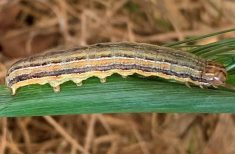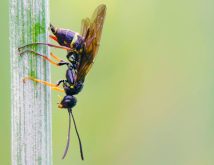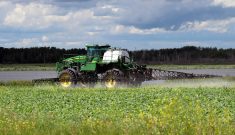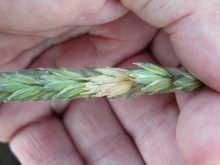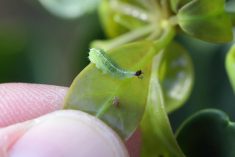Insecticide resistance on the Canadian Prairies is rare. Experts say producers have a pretty good handle on how to manage their insect crop pests with the products they have.
But that doesn’t mean resistance doesn’t happen. Resistance in insects occurs for the same basic reason it does in weeds, says a leading entomologist — the overuse of certain crop protection products.
“People use the same group or products over and over again,” says John Gavloski with Manitoba Agriculture.

“Eventually you will get a very, very small number of individuals that will survive the treatments and they will be genetically different from the susceptible population. They make other progeny containing these mutant genes that prevent the insecticide from killing them. That’s how the population starts to grow over time.”
Read Also

BASF donates seed, inputs to community growing projects
Growers or retailers interested in nominating a community project for the Fields of Purpose program in 2026 can contact their local BASF representative.
Although Prairie farmers shouldn’t be complacent (insecticide-resistant insects such as diamondback moths can fly in from other regions, for example), they’re fortunate that insects with resistance aren’t as prevalent as they are in many areas, says Boyd Mori, an assistant professor of agricultural and ecological entomology with the University of Alberta.
“I think we’re lucky in a lot of ways. We have harsh winters. We don’t have many species that have multiple generations per year that require multiple insecticide sprays, which can really contribute to the buildup of resistance.”
Not surprisingly, one of the best ways to avoid resistance is to use as little insecticide as possible. But how do you know those limits?
One of the strongest tools for making that “spray now” decision is an insect’s economic threshold — the point where there’s a sufficient population of the insect to cause yield losses on par with the cost of controlling them. These thresholds, which depend highly on the cost of the control and the value of the crop, can usually be found in the latest editions of provincial crop protection manuals.
“Use the thresholds properly and only spray when an insect is above the threshold,” says Gavloski. “Only using insecticides when necessary is step one because you’re not subjecting the insects to as many treatments and selection pressures.”
Another method is timing foliar insecticide applications for maximum effectiveness. Like economic thresholds, spraying windows differ between species.
Selective insecticides that target specific pests are an option in some cases, says Gavloski. “You have insecticides that target specific insects or groups of insects versus killing all insects. That allows natural biological controls that are out there to survive.”
Crop rotation, when possible, can also be an effective tool. But perhaps the most accessible action is rotating insecticides by their chemical groupings. “If any group has been relied on heavily recently or has recently not been working well, choose an insecticide from another group.”
Sometimes producers will rotate individual insecticides within the same group, in the process increasing resistance to that entire group of products.
“If an insect is resistant to one particular pyrethroid, for example, they’re likely to be resistant not just to the product but the group,” says Gavloski. “Usually, if an insect develops resistance to one of the chemicals in a group, often that resistance transfers to other products within that group just because they kill the insects in very similar ways. That’s quite common.”
Gavloski suggests getting to know the insecticide groups, which can usually be found in provincial crop protection guides and some online fact sheets. He also recommends doing research on any biological controls (such as beneficial insects) and figure out how to manage them, if feasible.
“Any kind of cultural or biological controls that would reduce the number of insecticides are good,” he says.
How to manage confirmed insecticide-resistant insects
Western Canadian agronomists and researchers have confirmed some resistant insect populations for farmers to look out for. These include alfalfa weevil and Colorado potato beetle.
In Alberta, Mori is aware of one insect pest with definitive insecticide resistance — alfalfa weevil in alfalfa seed production in the southern part of the province. These weevils are resistant to Group 3A pyrethroids.
Mori recommends organophosphate products for producers rotating out of the pyrethroids. However, he urges some caution when it comes to using the malathion active ingredient, which falls under the organophosphate umbrella. Although this ingredient has been registered for use on alfalfa weevils in seed production, he says farmer reviews haven’t been great.

“From what I’ve heard, farmers don’t think they have great control with it. It has more to do with the growing conditions though. It’s supposed to be sprayed at above 20 C in low winds. That doesn’t occur that often at the time of year they need to apply the product.”
There’s a semi-selective insecticide available for alfalfa weevil that goes by the trade name Coragen, a Group 28 product.
“It’s registered for suppression of alfalfa weevils and is more selective. It is supposed to be less toxic to bees.”
Although alfalfa weevil can be managed by rotating out of alfalfa seed crops, it’s not easy, says Mori.
“Alfalfa is a perennial, so these fields are usually two, three or four years of production in the same fields, which allows the alfalfa weevil population to stay within that same site. It’s grown multiple years in the same sites and is usually grown under contract for at least a couple of years. They just can’t rotate out of it easily.
“Right now, in the (alfalfa) seed crops, there’s really not much we can do except rotate modes of action.”
Colorado potato beetle is exceptionally good at developing resistance to insecticides, says Gavloski. Previous studies have found them resistant to one of the most oft-used insecticides on the market — Group 3A (pyrethroid) insecticides. Colorado potato beetle has also been found to have some resistance to Group 1B (organophosphates).
“It’s been a constant battle,” says Gavloski. “We’ve had insecticide resistance in (Colorado potato beetle) in Manitoba and across the Prairies for quite a while. It’s something potato growers have to battle with in any region where potatoes are grown in large acres.”
There are also pockets of resistance to Group 4A (neonicotinoids) developing among the potato-growing regions of the province, says Gavloski. Producers must be particularly careful with products in this group because they’re available as seed treatments, for in-furrow application and as foliar sprays. As a result, producers sometimes make the mistake of overusing this group in potato crops.
“With the neonicotinoids, we caution people that if they put them down in the furrow with the seed, they shouldn’t be following up with a spray because then you’re using two products from the same group in the same year,” he says.
In fact, labels of these products are quite clear on this. “Potato growers should be aware that if a neonicotinoid is used as a seed treatment or in-furrow, the label states, ‘Do not apply any subsequent applications of a Group 4 insecticide,’” he says.
Crop rotation can be an effective tool against potato beetles as it can be used to cause early-season populations of the pest to concentrate at the edge of fields, says Gavloski. Growers can take samples to verify this and, if so, focus product applications in those areas, in the process minimizing insecticide use.
There are some semi-selective insecticides registered for use against Colorado potato beetle in Canada. Some of these go by the trade names Coragen (a Group 28 diamide), Rimon (Group 15 benzoylureas), and Success and Entrust (both Group 5 spinosyns).
High temps can imitate resistance
Sometimes what appears to be resistance isn’t always resistance. A big culprit that can blur these lines is the temperature when foliar insecticides are applied, says James Tansey, provincial specialist of insect/vertebrate management for the Saskatchewan Ministry of Agriculture.
“Producers sometimes put these synthetic pyrethroids down when the weather is really hot and don’t get the effect that they’d like. They sometimes misunderstand that as potential resistance when it’s actually a temperature issue. There are temperature recommendations on product labels and these need to be adhered to.”




